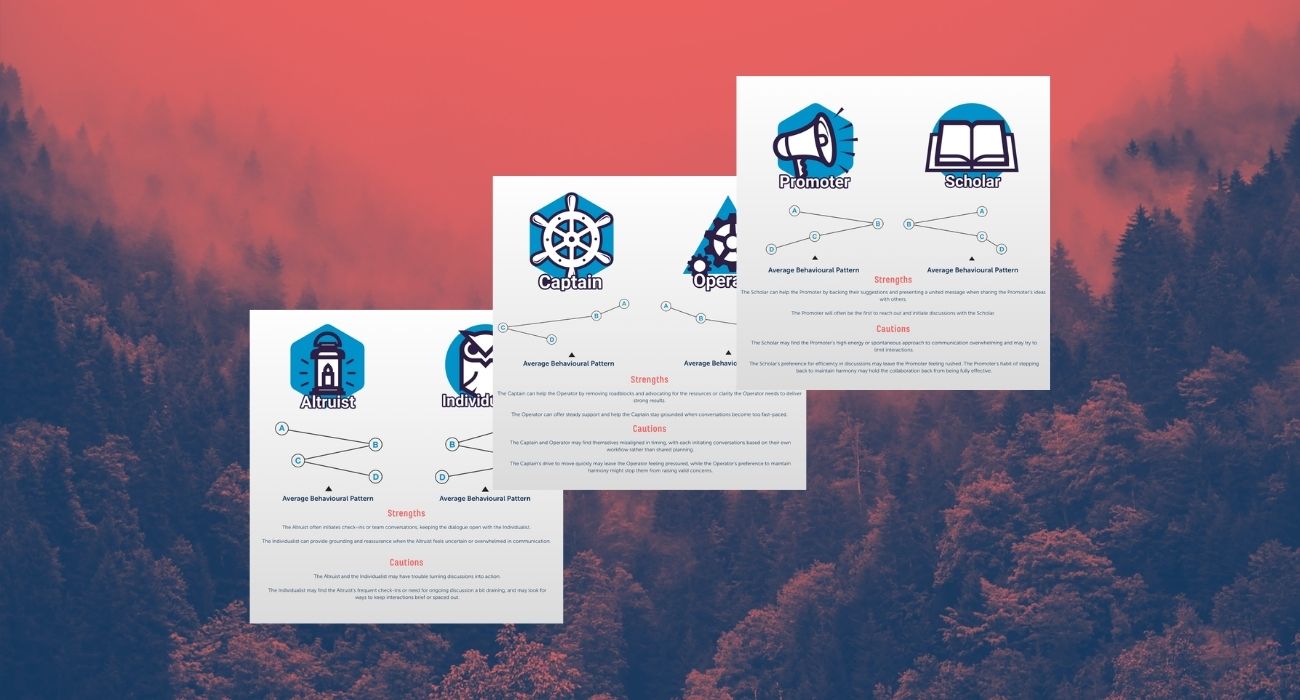Are you finding yourself clashing with a teammate who seems to approach every task completely differently to you? They might be focused on the big picture while you’re all over the detail. They may be quick to make decisions while you need research and evidence to justify. That disconnect can feel frustrating – but what if it’s actually the key to a stronger collaboration?
In the world of Predictive Index reference profiles, opposites don’t just attract – they complement, challenge, and strengthen each other. The differences that make collaboration tricky at first are often the exact things your team needs to succeed.
The key? Appreciation over frustration. Understanding your “opposite” can help turn friction into fuel for better outcomes.
In this blog, we’ll break down each profile pairing, highlighting the core strengths, and common friction points, and provide simple, actionable steps to turn differences into dynamic working relationships.
Altruist & Individualist
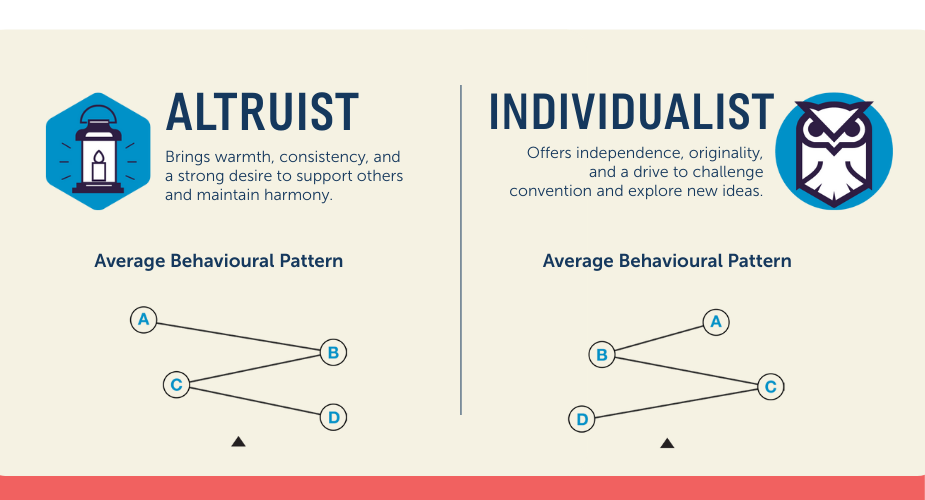
Strengths
- The Individualist can provide grounding and reassurance when the Altruist feels uncertain or overwhelmed in communication.
- The Individualist may spark new or unconventional ideas, while the Altruist helps shape those ideas into clear, actionable steps.
Cautions
- The Altruist’s desire to keep things moving may feel rushed to the Individualist, while the Individualist’s tendency to accommodate others can sometimes prevent honest or direct feedback from being shared.
- The Altruist may perceive the Individualist as vague or indirect, while the Individualist may see the Altruist as overly focused on specifics or minor details.
Tips & Takeaways
- The Individualist should create space for two-way dialogue by regularly checking in with the Altruist for their thoughts and input.
- The Individualist should stay open to the Altruist’s updates, while the Altruist can support the relationship by giving the Individualist uninterrupted time to reflect before responding.
- The Altruist should ensure shared ideas are captured clearly so the Individualist walks away with a clear understanding of priorities and next steps
Maverick & Guardian

Strengths
- The Maverick can help the Guardian by giving their ideas visibility and confidently championing their input in fast-paced or high-stakes discussions.
- The Guardian can help the Maverick slow down and reframe ideas through a more structured lens, especially when the Maverick is feeling blocked or impatient.
Cautions
- The Maverick’s drive to move forward without full alignment may leave the Guardian feeling uneasy, while the Guardian’s tendency to avoid conflict could prevent them from voicing important concerns.
- The Guardian may find the Maverick’s style too unfiltered or impulsive, while the Maverick may see the Guardian as overly cautious or resistant to change.
Tips & Takeaways
- The Maverick may naturally take the lead in conversations, but should be intentional about creating space for the Guardian to contribute, inviting their input and acknowledging when they offer strong, thoughtful ideas.
- The Guardian should stay open to the Maverick’s spontaneous updates, while the Maverick can support the relationship by allowing the Guardian time to process and respond in their own rhythm.
- The Guardian should confirm shared expectations and clarify responsibilities at the end of discussions to ensure the Maverick leaves with a clear understanding of next steps.
Captain & Operator
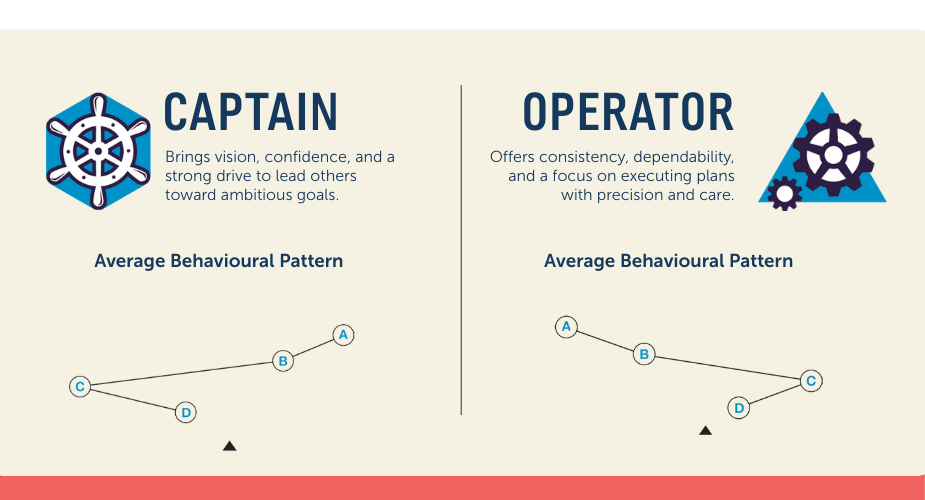
Strengths
- The Captain can help the Operator by removing roadblocks and advocating for the resources or clarity the Operator needs to deliver strong results.
- The Operator can offer steady support and help the Captain stay grounded when conversations become too fast-paced.
Cautions
- The Captain and Operator may find themselves misaligned in timing, with each initiating conversations based on their own workflow rather than shared planning.
- The Operator may feel that the Captain skips over important context, while the Captain may see the Operator as getting caught in unnecessary detail.
Tips & Takeaways
- The Captain may often lead the conversation, but should create space for the Operator to share their thoughts and acknowledge when the Operator brings forward thoughtful or practical contributions.
- The Captain and Operator should aim to check for mutual understanding during conversations and clarify any assumptions before moving on to the next topic.
- The Operator should stay open to the Captain’s fast-moving ideas, while the Captain should give the Operator time to process and respond in their own way.
Persuader & Artisan
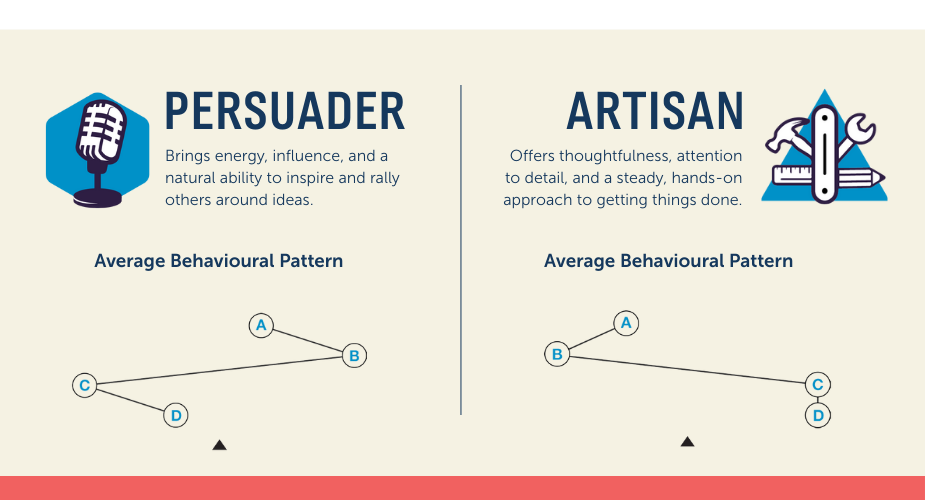
Strengths
- The Artisan can offer calm, steady support when the Persuader feels stuck or encounters pushback in communication.
- The Persuader often brings big-picture enthusiasm, while the Artisan helps shape those ideas into realistic, actionable steps.
Cautions
- The Persuader’s quick pace and tendency to jump between ideas may leave the Artisan feeling unsettled, while the Artisan’s desire to keep the peace might prevent them from expressing concerns or pushing back.
- The Artisan may feel the Persuader glosses over important details, while the Persuader may find the Artisan too caught up in logistics or process.
Tips & Takeaways
- The Persuader may naturally guide the conversation, but should make a conscious effort to invite the Artisan to share their perspective and recognise when their insights shape the outcome. The Persuader can help the Artisan by amplifying their contributions and ensuring their practical insights are heard in group settings.
- The Persuader should give the Artisan a heads-up before launching into discussions, while the Artisan can strengthen the flow by checking in on the Persuader’s expectations or priorities upfront.
- The Artisan should take a moment to recap any agreed outcomes to ensure the Persuader walks away with clarity and momentum.
Venturer & Specialist
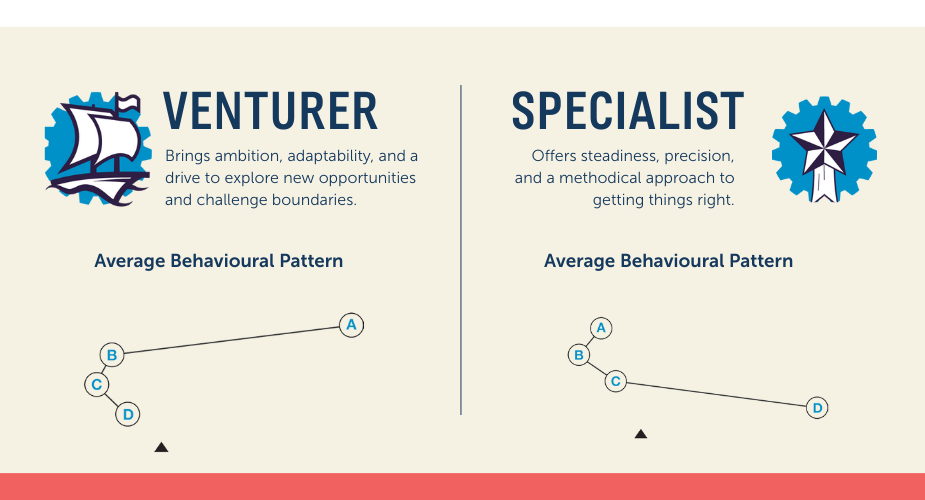
Although the Venturer and the Specialist may not appear opposite when comparing their profiles horizontally, they reveal clear differences when viewed through a vertical lens.
Strengths
- The Specialist can offer calm, steady input when the Venturer feels blocked or impatient, helping bring focus back to what’s important.
- The Venturer often pushes into new territory, while the Specialist helps assess risk, identify gaps, and break bold ideas into manageable, step-by-step actions.
Cautions
- Both the Venturer and the Specialist may prefer to work independently, which can result in missed opportunities for proactive communication unless intentionally scheduled.
- The Specialist may see the Venturer as jumping between ideas without enough clarity, while the Venturer may feel the Specialist is getting caught in the minor details.
Tips & Takeaways
- The Venturer may naturally take charge in discussions, but should pause to invite the Specialist to contribute their perspective and acknowledge their technical insights when shared.
- The Specialist and Venturer should set aside time to align on priorities, especially when working at different speeds or focusing on different levels of detail.
- The Specialist should confirm expectations in writing where possible, helping the Venturer stay focused and aligned on what needs to happen next.
Collaborator & Controller/Analyser
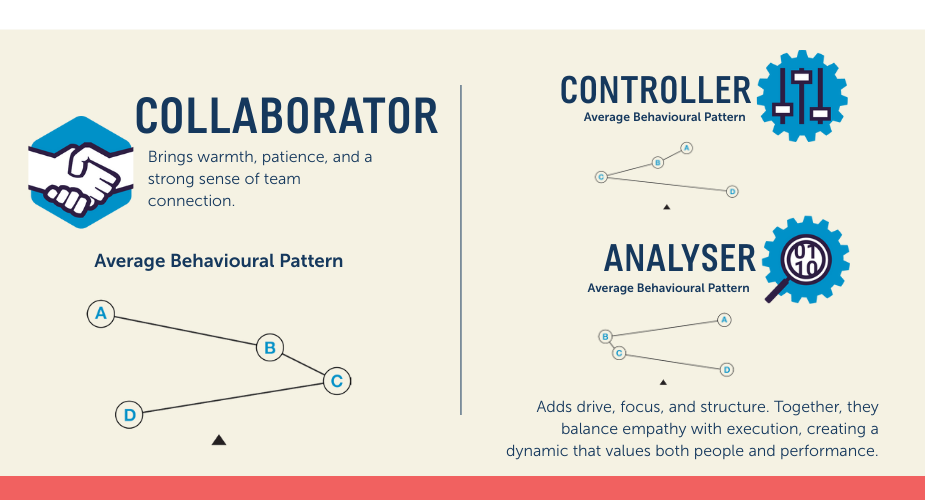
Strengths
- The Collaborator is able to encourage and act as a counter balance when the Controller & Analyzer feel frustrated by their communication.
- The Collaborator can discuss broad ideas, but the Controller & Analyzer are good at translating the Collaborator’s suggestions into specifics.
Cautions
- The Controller & Analyzer may dominate the agenda, and the Collaborator’s ideas or concerns may get overlooked.
- The Collaborator’s tendency to adapt or yield to preserve the relationship, may limit the effectiveness of collaboration with the Controller & Analyzer. The Controller & Analyzer’s tendency to rush conversations may frustrate the Collaborator.
Tips & Takeaways
- The Collaborator should set up a time to speak with the Controller & Analyzer rather than dropping by and asking the Controller & Analyzer questions in the spur of the moment.
- The Collaborator should be receptive to communications from the Controller & Analyzer, but the Controller & Analyzer should also provide the Collaborator with space and time to think things through alone.
- The Controller & Analyzer should make sure that the Collaborator is clear on specific action items and next steps when they end conversations.
Promoter & Scholar/Strategist
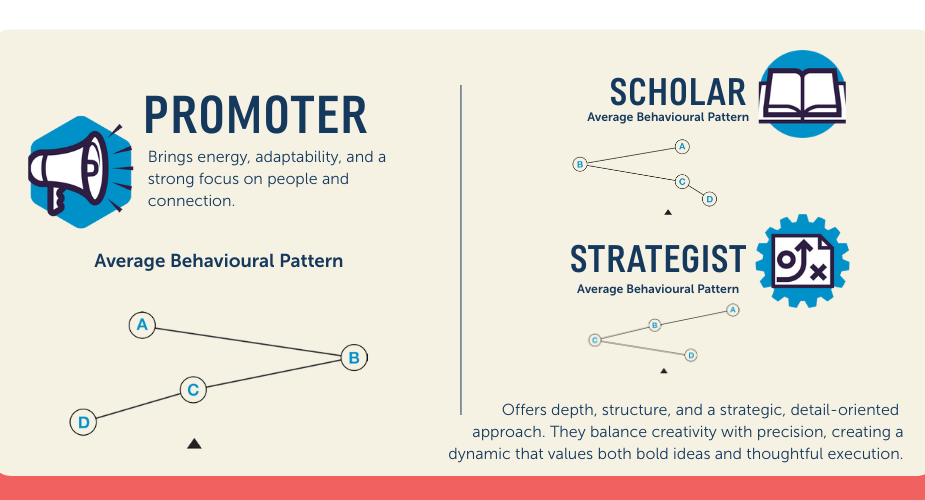
Strengths
- The Scholar & Strategist can help the Promoter by backing their suggestions and presenting a united message when sharing the Promoter’s ideas with others.
- The Promoter can bring energy and balance when the Scholar & Strategist feel overwhelmed or disengaged in communication.
Cautions
- The Scholar & Strategist may find the Promoter’s high energy or spontaneous approach to communication overwhelming and may try to limit interactions.
- The Scholar & Strategist’s preference for efficiency in discussions may leave the Promoter feeling rushed. The Promoter’s habit of stepping back to maintain harmony may hold the collaboration back from being fully effective.
Tips & Takeaways
- The Scholar & Strategist may take the lead in structuring discussions, but they should actively invite the Promoter to share their thoughts, checking in for feedback and highlighting when the Promoter brings forward strong ideas.
- The Promoter should aim to book time with the Scholar & Strategist rather than catching them off guard when they are in deep work.
- The Scholar & Strategist should clearly summarise agreed outcomes and responsibilities to ensure the Promoter feels confident and aligned after conversations.
Adapter
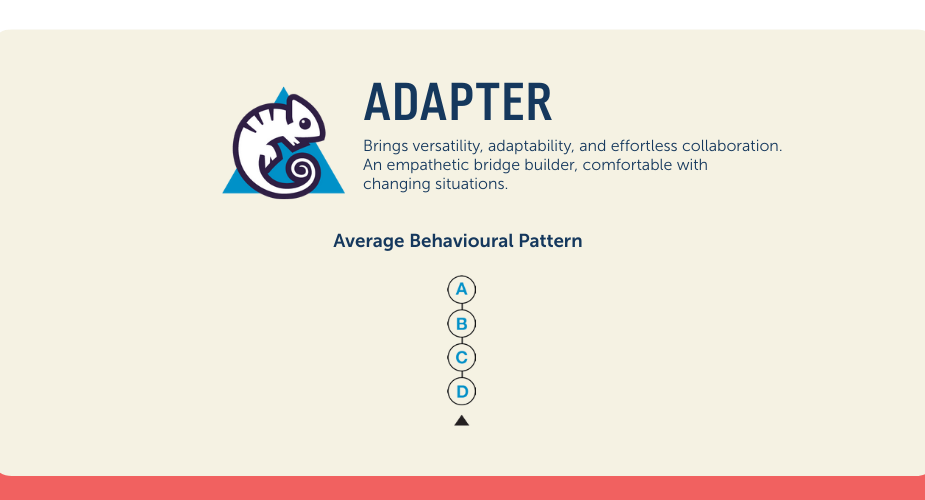
The Adapter is unique among the Predictive Index Reference Profiles because they don’t exhibit a strong behavioural lean in any one direction. Instead of showing pronounced peaks or dips in the four drives (Dominance, Extraversion, Patience & Formality), Adapters typically have all four drives clustered near the midpoint of the graph. This results in a highly balanced profile, where no single factor strongly defines their workplace behaviour.
Because of this even distribution, Adapters are often seen as flexible, accommodating, and able to adjust their style depending on the needs of the situation or the people around them. They are naturally versatile and can often relate to a wide range of behavioural styles, making them strong collaborators and adaptable team members in environments that require shifting gears frequently.
Rather than leaning into one behavioural pattern, they can dial behaviours up or down as needed. This means they may not have a PI profile opposite in the same way the other PI profiles do.
Turn Insight into Action
Understanding your PI profile opposite is just the beginning. If this sparked some “aha” moments, why not take it a step further?
With the PI Inspire module, you can map your relationship guide with any other PI user. You’ll get practical, personalised insights on how to communicate, collaborate, and succeed together.
And if your team hasn’t taken the PI yet? Now’s the perfect time.
When everyone on your team understands their profile – and how others do – it creates the foundation for stronger communication, less conflict, and better results.
Take The Predictive Index today and start working better together.
